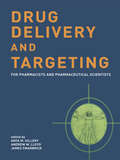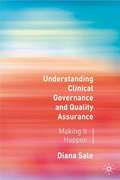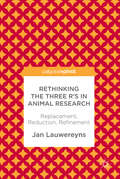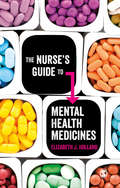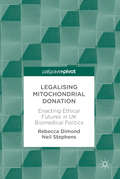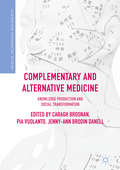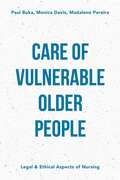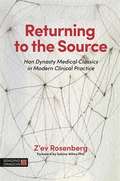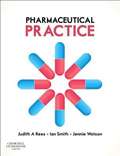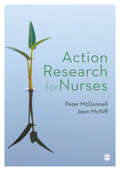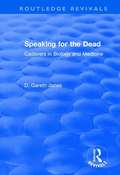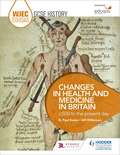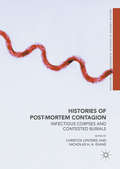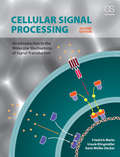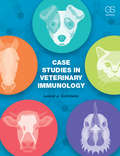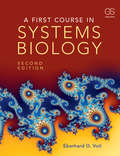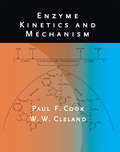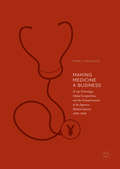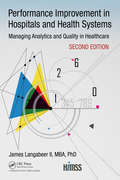- Table View
- List View
Drug Delivery and Targeting (PDF)
by Anya M. Hillery Andrew W. Lloyd James SwarbrickThe advances in biotechnology and molecular biology over recent years have resulted in a large number of novel molecules with the potential to revolutionize the treatment and prevention of disease. However, such potential is severely compromised by significant obstacles to delivery of these drugs in vivo. These obstacles are often so great that effective drug delivery and targeting is now recognized as the key to effective development of many therapeutics. Advanced drug delivery and targeting can offer significant advantages to conventional drugs, such as increased efficiency, convenience, and the potential for line extensions and market expansion. An accessible and easy-to-read textbook, Drug Delivery and Targeting for Pharmacists and Pharmaceutical Scientists is the first book to provide a comprehensive introduction to the principles of advanced drug delivery and targeting, their current applications and potential future developments, including: *Methods to optimize therapeutic efficacy, and the related commercial implications *Difficulties with drug absorption, unwanted distribution and premature inactivation / elimination *Attempts to minimize toxicity or alter immunogenicity *Methods to achieve rate-controlled drug release and effective drug targeting *Novel and established routes of delivery *Use of new generation technologies such as biosensors, microchips, stimuli-sensitive hydrogels and plasmid-based gene therapy This volume is indispensable for pharmaceutical students, scientists and researchers.
Understanding Clinical Governance and Quality Assurance (PDF)
by Diana SaleThis book enables healthcare professionals to make clinical governance a reality at all levels of a health care organisation. It covers techniques and approaches to support the successful implementation of Clinical Governance, including evidence-based practice, integrated care pathways, clinical risk management and other essential skills such as project management, writing a strategy and facilitating groups. Each chapter is supported with examples of how the theory works in practice.
Rethinking the Three R's in Animal Research: Replacement, Reduction, Refinement
by Jan LauwereynsThis work challenges the current reliance on "The Three R's" or Replacement, Reduction and Refinement which direct most animal research in the behavioral sciences. The author argues that these principles that were developed in the 1950's to guide the use of animals in research studies are outdated. He suggests that the notions of refinement and reduction are often ill-defined and can be useful only in cases where replacement is impossible.
Rethinking the Three R's in Animal Research: Replacement, Reduction, Refinement
by Jan LauwereynsThis work challenges the current reliance on "The Three R's" or Replacement, Reduction and Refinement which direct most animal research in the behavioral sciences. The author argues that these principles that were developed in the 1950's to guide the use of animals in research studies are outdated. He suggests that the notions of refinement and reduction are often ill-defined and can be useful only in cases where replacement is impossible.
The Nurse's Guide to Mental Health Medicines
by Elizabeth Jane HollandHave you ever wished there was a simple guide to mental health medicines that can give you the key facts quickly? If the answer to that question is yes then look no further. Each chapter provides a short and easy-to-read overview of the different drug types used in mental health nursing. It focusses only on the need to know information and the associated risks and side effects. The chapters also provide a short medicines list that gives you fast facts relating to the most common drugs used in practice. An invaluable, pocket sized guide to a complex subject. Key features: Simple layout with clear tables putting the facts at your fingertips Written by nurses for nurses providing the perfect amount of detail for the busy student or practitioner Clear and simple language combined with real world case studies to cut through the jargon and terminology
Legalising Mitochondrial Donation
by Rebecca Dimond Neil StephensIn 2015 the UK became the first country in the world to legalise mitochondrial donation, a controversial germ line reproductive technology to prevent the transmission of mitochondrial disease. Dimond and Stephens track the intense period of scientific and ethical review, public consultation and parliamentary debates preceeding the decision. They draw on stakeholder accounts and public documents to explore how patients, professionals, institutions and publics mobilised within ‘for’ and ‘against’ clusters, engaging in extensive promissory, emotional, bureaucratic, ethical, embodied and clinical labour to justify competing visions of an ethical future. They describe how this decision is the latest iteration of a UK sociotechnical imaginary in which the further liberalization of human embryo research and use is rendered legitimate and ethical through modes of consultation and permissive but strictly regulated licensing. Overall, this book presents a timely, multi-dimensional, and sociological account of a globally significant landmark in the history of human genetics, and will be relevant to those with an interest in genetics, Science, Technology and Society, the sociology of medicine, reproductive technology, and public policy debate.
Complementary and Alternative Medicine: Knowledge Production and Social Transformation (Health, Technology and Society)
by Caragh Brosnan Pia Vuolanto Jenny-Ann Brodin DanellThis book examines how complementary and alternative medicine (CAM) – as knowledge, philosophy and practice – is constituted by, and transformed through, broader social developments. Shifting the sociological focus away from CAM as a stable entity that elicits perceptions and experiences, chapters explore the forms that CAM takes in different settings, how global social transformations elicit varieties of CAM, and how CAM philosophies and practices are co-produced in the context of social change. Through engagement with frameworks from Science and Technology Studies (STS), CAM is reconceptualised as a set of practices and knowledge-making processes, and opened up to new forms of analysis. Part 1 of the book explores how and why boundaries within CAM and between CAM and other health practices, are being constructed, challenged and changed. Part 2 asks how CAM as material practice is shaped by politics and regulation in a range of national settings. Part 3 examines how evidence is being produced and used in CAM research and practice. Including studies of CAM in Eastern and Western Europe, Asia, and North and South America, the volume will appeal to postgraduate students, researchers and health practitioners.
Complementary and Alternative Medicine: Knowledge Production and Social Transformation (Health, Technology and Society)
by Caragh Brosnan Pia Vuolanto Jenny-Ann Brodin DanellThis book examines how complementary and alternative medicine (CAM) – as knowledge, philosophy and practice – is constituted by, and transformed through, broader social developments. Shifting the sociological focus away from CAM as a stable entity that elicits perceptions and experiences, chapters explore the forms that CAM takes in different settings, how global social transformations elicit varieties of CAM, and how CAM philosophies and practices are co-produced in the context of social change. Through engagement with frameworks from Science and Technology Studies (STS), CAM is reconceptualised as a set of practices and knowledge-making processes, and opened up to new forms of analysis. Part 1 of the book explores how and why boundaries within CAM and between CAM and other health practices, are being constructed, challenged and changed. Part 2 asks how CAM as material practice is shaped by politics and regulation in a range of national settings. Part 3 examines how evidence is being produced and used in CAM research and practice. Including studies of CAM in Eastern and Western Europe, Asia, and North and South America, the volume will appeal to postgraduate students, researchers and health practitioners.
Care of Vulnerable Older People
by Paul Buka Madalene Pereira Monica DavisThe findings of key reports highlight the need to raise awareness of the failures in health and social care systems to safeguard vulnerable older people. In this important text, a team of expert authors brings the focus to how legislation, ethics and national policy can be applied to the context of protecting 'at risk' older adults. Clear and accessible, the book will improve nurses' skills in safeguarding vulnerable older people. An essential read for students and qualified nurses alike, this text provides the reader with a solid foundation for clinical decision-making and safeguarding vulnerable older people, as well as a forum for discussion and reflection.
Returning to the Source: Han Dynasty Medical Classics in Modern Clinical Practice
by Professor Z'Ev Rosenberg Ken Rose Dr Sabine Wilms Blair ThornleyChinese Medicine constantly refers back to its sources in order to initiate the new. Its source code is in the Han Dynasty medical classics, and in this handbook esteemed practitioner and educator Professor Z'ev Rosenberg shares the knowledge from his study of these classic texts and his experiences treating difficult cases. In the tradition of the scholar-physician commentaries, Z'ev Rosenberg comments on the Simple Questions that introduce the core principles of the Inner Canon; explaining how these inform his methodology of diagnosis and advising on how biomedical diseases can be retranslated into sophisticated Chinese medical diagnoses including patterns of differentiation, sequential diagnosis, synchronicity, season, climate and environment. He discusses how Chinese medicine can use unique diagnostic parameters to rebalance the landscape and chronobiology of the body and address the greatest clinical challenges of our time, including the contemporary epidemic of autoimmune disorders.
Pharmaceutical Practice (PDF)
by Judith A. Rees Ian Smith Jennie WatsonThe fifth edition of Pharmaceutical Practice has been totally overhauled and restructured to bring the contents completely up to date and to reflect emerging new roles for pharmacists both within the traditional employment areas of hospital and community pharmacy, as well as other developing roles supporting the public health agenda, governance, risk management, prescribing and pharmacoeconomics. It covers a wide range of subjects relevant to pharmacy practice, including communication skills, managing a business, quality assurance, dispensing, calculations, packaging, storage and labeling of medicines, sterilization, prescriptions, hospital-based services, techniques and treatments, adverse drug reactions, cost-benefit, and medicines management. - Each chapter begins with Study Point and ends with Key Points to reinforce learning. - Appendices include medical abbreviations, Latin terms and abbreviations, systems of weights and measurements, presentation skills and key references. - Self-assessment questions for more complex areas of pharmaceutical practice. - New chapters on control of medicines; control of health professionals and their staff; ethics in practice; - Standard Operating Procedures; structure and organisation of pharmacy; veterinary pharmacy; appliances; public health, and pharmacy interventions. - New editor on the team, Jennie Watson. - Many new contributors, comprising practicing pharmacists, teachers of pharmacy, and pharmacists with joint appointments between hospital/community pharmacy and universities
Action Research for Nurses (PDF)
by Jean Mcniff Peter McdonnellNurses work in complex situations with daily challenges, where the needs of each patient represent unique demands. Action research helps nurses to investigate their practices as reflective practitioners, allowing them to ask ‘What is going on? How do we understand the existing situation? How do we improve it?’ This book supports nurses in investigating their own professional practices in order to develop the new insights and approaches: · embodying holistic perspectives in dialogical and relational forms of individual and organisational learning, · equal emphasis on processes and outcomes; · welcoming all participants’ contributions , and listening to all voices; · developing a patient-centred focus where people are involved in their own healing; · building communities of enquiring practices. This book is intended for undergraduate student nurses, qualified practising nurses in clinical settings who may or may not be engaged in formal professional education courses and nurse educators and managers.
Action Research for Nurses
by Jean Mcniff Peter McdonnellNurses work in complex situations with daily challenges, where the needs of each patient represent unique demands. Action research helps nurses to investigate their practices as reflective practitioners, allowing them to ask ‘What is going on? How do we understand the existing situation? How do we improve it?’ This book supports nurses in investigating their own professional practices in order to develop the new insights and approaches: · embodying holistic perspectives in dialogical and relational forms of individual and organisational learning, · equal emphasis on processes and outcomes; · welcoming all participants’ contributions , and listening to all voices; · developing a patient-centred focus where people are involved in their own healing; · building communities of enquiring practices. This book is intended for undergraduate student nurses, qualified practising nurses in clinical settings who may or may not be engaged in formal professional education courses and nurse educators and managers.
Speaking For The Dead: Cadavers In Biology And Medicine (Routledge Revivals Series (PDF)
by D. Gareth JonesThis was first published in 2000: This text explores issues surrounding the use of human cadavers and human tissues in science and medicine. This is an area of increasing significance in contemporary society, as more and more techniques become available for manipulating human genes and human material (including embryos, body organs and brain tissue). These issues are explored through case studies from contemporary society. Some of the most topical issues examined include plastination of human bodies as an art form, the use of biopsies from surgical operations, the ethics of using human DNA and stem cells in research, and the debate surrounding the transplantation of animal tissue and organs into humans.
WJEC Eduqas GCSE History: Changes in Health and Medicine in Britain, c.500 to the present day (PDF)
by R. Paul Evans Alf WilkinsonBring out the best in every student, enabling them to develop in-depth subject knowledge and historical skills with the market-leading series for WJEC Eduqas, fully updated for 2016 to help you navigate the new content and assessment requirements with ease. - Maps the content against the key questions in the 2016 specification, with thorough and reliable course coverage written by a team of experienced authors, teachers and examiners - Motivates students to increase their subject knowledge by following a clear, detailed narrative that leads learners topic by topic through the important issues, events and concepts - Progressively builds historical understanding and skills as students work through a range of engaging classroom activities with structured support at every stage - Boosts students' confidence approaching assessment, providing numerous opportunities to practise different types of exam-style questions - Captures learners' interest by offering a rich variety of source material that brings historical periods to life, enhancing understanding and enjoyment throughout the course
Histories of Post-Mortem Contagion: Infectious Corpses and Contested Burials (Medicine and Biomedical Sciences in Modern History)
by Christos Lynteris Nicholas H EvansThis edited volume draws historians, anthropologists and archaeologists together to explore the contested worlds of epidemic corpses and their disposal. Why are burials so frequently at the center of disagreement, recrimination and protest during epidemics? Why are the human corpses produced in the course of infectious disease outbreaks seen as dangerous, not just to the living, but also to the continued existence of society and civilization? Examining cases from the Black Death to Ebola, contributors challenge the predominant idea that a single, universal framework of contagion can explain the political, social and cultural importance and impact of the epidemic corpse.
Histories of Post-Mortem Contagion: Infectious Corpses and Contested Burials (Medicine and Biomedical Sciences in Modern History)
by Christos Lynteris Nicholas H A EvansThis edited volume draws historians, anthropologists and archaeologists together to explore the contested worlds of epidemic corpses and their disposal. Why are burials so frequently at the center of disagreement, recrimination and protest during epidemics? Why are the human corpses produced in the course of infectious disease outbreaks seen as dangerous, not just to the living, but also to the continued existence of society and civilization? Examining cases from the Black Death to Ebola, contributors challenge the predominant idea that a single, universal framework of contagion can explain the political, social and cultural importance and impact of the epidemic corpse.
Cellular Signal Processing: An Introduction to the Molecular Mechanisms of Signal Transduction
by Friedrich Marks Ursula Klingmüller Karin Müller-DeckerCellular Signal Processing offers a unifying view of cell signaling based on the concept that protein interactions act as sophisticated data processing networks that govern intracellular and extracellular communication. It is intended for use in signal transduction courses for undergraduate and graduate students working in biology, biochemistry, bioinformatics, and pharmacology, as well as medical students. The text is organized by three key topics central to signal transduction: the protein network, its energy supply, and its evolution. It covers all important aspects of cell signaling, ranging from prokaryotic signal transduction to neuronal signaling, and also highlights the clinical aspects of cell signaling in health and disease. This new edition includes expanded coverage of prokaryotes, as well as content on new developments in systems biology, epigenetics, redox signaling, and small, non-coding RNA signaling.
Case Studies in Veterinary Immunology
by Laurel GershwinCase Studies in Veterinary Immunology presents basic immunological concepts in the context of actual cases seen in clinics. It is intended for veterinary medicine students, interns, residents, and veterinarians, and serves as a valuable supplement and companion to a variety of core immunology textbooks and courses. The book includes cases describing primary immune system defects, secondary immune system defects, and hypersensitivity and autoimmune disorders, as well as dysproteinemias and lymphoid neoplasia. Drawing on the successful approach of Geha’s Case Studies in Immunology, each representative case is preceded by a discussion of the principles underlying that specific immunological mechanism. The case itself includes the presenting complaint (signalment), physical examination findings, pertinent diagnostic laboratory data, diagnosis, and treatment options. In those instances in which a specific disorder occurs in both animals and humans, the differences and similarities in the immunological mechanisms and manifestations of the disease are explored. End of case questions highlight important concepts and serve as a review aid for students. Details on standard vaccines and vaccination schedules, as well as descriptions of the types of assays used for evaluation of the immune system, are included as appendices.
A First Course in Systems Biology
by Eberhard VoitA First Course in Systems Biology is an introduction for advanced undergraduate and graduate students to the growing field of systems biology. Its main focus is the development of computational models and their applications to diverse biological systems. The book begins with the fundamentals of modeling, then reviews features of the molecular inventories that bring biological systems to life and discusses case studies that represent some of the frontiers in systems biology and synthetic biology. In this way, it provides the reader with a comprehensive background and access to methods for executing standard systems biology tasks, understanding the modern literature, and launching into specialized courses or projects that address biological questions using theoretical and computational means. New topics in this edition include: default modules for model design, limit cycles and chaos, parameter estimation in Excel, model representations of gene regulation through transcription factors, derivation of the Michaelis-Menten rate law from the original conceptual model, different types of inhibition, hysteresis, a model of differentiation, system adaptation to persistent signals, nonlinear nullclines, PBPK models, and elementary modes. The format is a combination of instructional text and references to primary literature, complemented by sets of small-scale exercises that enable hands-on experience, and large-scale, often open-ended questions for further reflection.
Enzyme Kinetics and Mechanism
by Paul F. Cook W. W. ClelandEnzyme Kinetics and Mechanism is a comprehensive textbook on steady-state enzyme kinetics. Organized according to the experimental process, the text covers kinetic mechanism, relative rates of steps along the reaction pathway, and chemical mechanism—including acid-base chemistry and transition state structure. Practical examples taken from the literature demonstrate theory throughout. The book also features numerous general experimental protocols and how-to explanations for interpreting kinetic data. Written in clear, accessible language, the book will enable graduate students well-versed in biochemistry to understand and describe data at the fundamental level. Enzymologists and molecular biologists will find the text a useful reference.
Enzyme Kinetics and Mechanism
by Paul F. Cook W. W. ClelandEnzyme Kinetics and Mechanism is a comprehensive textbook on steady-state enzyme kinetics. Organized according to the experimental process, the text covers kinetic mechanism, relative rates of steps along the reaction pathway, and chemical mechanism—including acid-base chemistry and transition state structure. Practical examples taken from the literature demonstrate theory throughout. The book also features numerous general experimental protocols and how-to explanations for interpreting kinetic data. Written in clear, accessible language, the book will enable graduate students well-versed in biochemistry to understand and describe data at the fundamental level. Enzymologists and molecular biologists will find the text a useful reference.
Making Medicine a Business: X-ray Technology, Global Competition, and the Transformation of the Japanese Medical System, 1895-1945
by Pierre-Yves DonzéThis book goes back to the origins of the transformation of health and medicine into a business, during the first part of the twentieth century, focusing on the example of Japan. In the past hundred years, medicine has gone from being a charitable activity to a large economic sector, amounting to 12–15% of the GDP in many developed countries, and one of the fastest-growing businesses around the world. Despite the mounting presence of the medical industry, there is a lack of academic work detailing this major transformation. The objective of this book is to fill this gap and address the following question: how did medicine become a business? Using over ten years of research in the field, Pierre-Yves Donzé argues that economic factors and business factors were decisive in transforming the way that medicine enters our lives. This book will be of interest to historians of medicine, business historians, health economists, scholars in medical humanities, and more.
Making Medicine a Business: X-ray Technology, Global Competition, and the Transformation of the Japanese Medical System, 1895-1945
by Pierre-Yves DonzéThis book goes back to the origins of the transformation of health and medicine into a business, during the first part of the twentieth century, focusing on the example of Japan. In the past hundred years, medicine has gone from being a charitable activity to a large economic sector, amounting to 12–15% of the GDP in many developed countries, and one of the fastest-growing businesses around the world. Despite the mounting presence of the medical industry, there is a lack of academic work detailing this major transformation. The objective of this book is to fill this gap and address the following question: how did medicine become a business? Using over ten years of research in the field, Pierre-Yves Donzé argues that economic factors and business factors were decisive in transforming the way that medicine enters our lives. This book will be of interest to historians of medicine, business historians, health economists, scholars in medical humanities, and more.
Performance Improvement In Hospitals And Health Systems (2nd edition) (PDF)
by James R. Langabeer IIHealthcare Organizations offer significant opportunities for change and improvement in their overall performance. Hospitals and clinics are generally large, complex, and inefficient, and need serious development in process workflow and management systems, which will ultimately lead to better patient and financial outcomes. The National Academy of Medicine has stated that hospital systems are broken, and that they must begin by "… improving hospital efficiency and patient flow, and using operational management methods and information technologies." In fact, costs and quality are two of the important aspects of the "triple aim" in healthcare. One area that offers significant potential for improvement is through the application of performance improvement methods to patient and process flows. Performance improvement has a significant impact on a hospital’s over financial and strategic performance. Performance improvement involves the deployment of quantitative and scientific methods to model and influence the functioning of organizations. Performance improvement professionals are tasked with managing a variety of activities, such as deploying new information technologies, serving as project managers for construction events, re-engineering departmental process workflow, eliminating bottlenecks, and improving the flow and movement of patients between resource-intensive clinical areas. All of these are high risk, and require use of advanced, sophisticated methods to improve efficiency and quality, while minimizing disruptions from change. This updated edition is a comprehensive and concise guide to performance improvement in healthcare. It describes the management engineering principles focused on designing optimal management and information systems and processes. Case studies and examples are integrated throughout all chapters.
